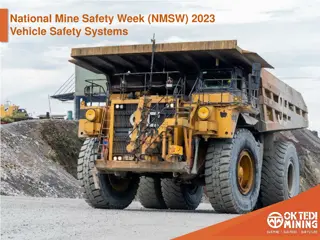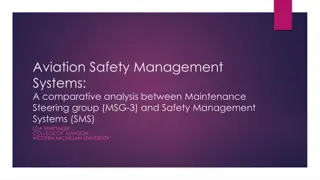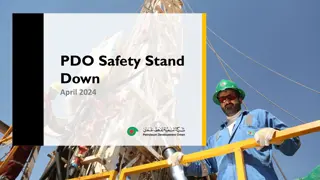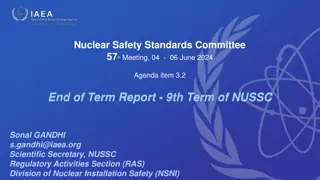Process Safety Management in Canada
This module introduces Process Safety Management (PSM) as a framework for identifying and managing process risks in the context of various engineering disciplines. The goal of PSM is to prevent major hazard incidents by proactively addressing process hazards. The content covers the principles of PSM, relevant regulations in Canada, and key elements such as hazard identification, risk assessment, and workforce involvement.
Download Presentation

Please find below an Image/Link to download the presentation.
The content on the website is provided AS IS for your information and personal use only. It may not be sold, licensed, or shared on other websites without obtaining consent from the author.If you encounter any issues during the download, it is possible that the publisher has removed the file from their server.
You are allowed to download the files provided on this website for personal or commercial use, subject to the condition that they are used lawfully. All files are the property of their respective owners.
The content on the website is provided AS IS for your information and personal use only. It may not be sold, licensed, or shared on other websites without obtaining consent from the author.
E N D
Presentation Transcript
Process Safety Management Valerie Orr Shazad Barghi Ralph Buchal
Introduction Module Outline What is PSM? Importance of PSM PSM Systems Rules, Regulations, and Guideline for PSM in Canada References and further reading 2
MODULE OUTLINE: PROCESS SAFETY MANAGEMENT Description: This module is meant to provide an introduction to process safety management (PSM). In a very simple sense, PSM is a framework for identifying and managing process risks. It is a type of safety management system that is specific for the process industries. Therefore, the principles are relevant to all disciplines of engineering involved in a process facility and are also broadly applicable to other manufacturing industries. The ultimate goal of PSM is to prevent the occurrence of major hazard incidents which are not appropriately addressed through traditional occupational health and safety procedures. This is due to the fact that many serious unplanned incidents are many times not simply attributable to any individual operator error. PSM strives to ensure all hazards of a process are identified and effectively managed for the lifetime of the process, regardless of changes in personnel, organization, or environment. The principles of PSM as taught in this module are based on a particular reference from the American Institute of Chemical Engineers Center for Chemical Process Safety (AIChE CCPS). 3
Primary Reading Materials: RISK BASED PROCESS SAFETY MANAGEMENT (2007) Introduction to the twenty elements of PSM developed by the American Institute of Chemical Engineers Center for Chemical Process Safety SAFETY MANAGEMENT: A COMPREHENSIVE APPROACH TO DEVELOPING A SUSTAINABLE SYSTEM (2012) A comprehensive look at the factors that affect safety improvements and the effectiveness of a process safety management system. Large focus on the human factors which affect the adoptions of safe work practices, such as leadership and behavior. 4
Chapter Title 1 Introduction Contents The importance of PSM in the prevention of major hazard incidents Brief History and recent examples Rules and Regulations for PSM in Canada PSM Systems Elements of Process Safety Management 1. 2. 3. 4. 5. 6. 7. Process safety culture Compliance Competence Workforce involvement Stakeholder outreach Hazard identification & risk management Knowledge management 2 Commitment to PSM 3 Hazard Identification and Risk Assessment 4 Risk Management 8. 9. 10. Safe work practices 11. Asset integrity & reliability 12. Contractor management 13. Management of change 14. Operational readiness 15. Conduct of operations 16. Emergency preparedness 17. Incident investigation 18. Auditing 19. Metrics & measurements 20. Management review Operating procedures Training & performance 5 Enhancing PSM 5
PSM is the proactive application of management principles to a process for the prevention of loss of containment events PSM is a system for dealing with: human performance in complicated systems that involve inherent risk What is Process Safety Management (PSM)? Aviation Safety Expert and Pilot Chelsey Sullenberger (Interview on the application of aviation systems safety lessons to medicine CBC Radio 2013) This applies to the process industries too Any site which stores, handles or manufactures hazardous substances or energy will have an inherent risk Introduction Commitment to PSM Hazard & Risk Assessment Risk Enhancing PSM Introduction 6 Management
A loss of containment incident (LoC) occurs when a harmful substance or energy is released outside of the equipment which is meant to contain it [1,2,3,4] In some countries the amount of substance released dictates whether the incident is reportable to the government Also, in some countries, the amount of hazardous material contained in either equipment or at a facility can determine if implementation of PSM systems is required; e.g., Environment Canada Environmental Regulations, US OSHA PSM Rule 1910.119 [3, 5] Loss of Containment 7
Faulty gauge causes an overfill of a storage tank spilling 10000 kg of ethanol 2000 kg of crude oil leaks from corroded piping Operator opens process valve and causes acid spill and gets burned Examples of PSM incidents Introduction Commitment to PSM Hazard & Risk Assessment Risk Enhancing PSM Introduction 8 Management
PSM systems are meant for industries handling, storing, or manufacturing hazardous substances Hazardous substances are defined by their reactivity, toxicity, flammability, or other dangerous properties by the Canadian Environmental Protection Act Part 8 Section 200 [5] Intent of PSM PSM is primarily intended for the process industries and is typically applied at a facility level Introduction Commitment to PSM Hazard & Risk Assessment Risk Enhancing PSM Introduction 9 Management
PROACTIVE REACTIVE Implementing countermeasures to prevent an incident Implementing countermeasures after an incident has occurred PSM is a Proactive Risk Based Approach Perform hazard analysis and risk assessment Perform incident investigation and determine root cause Practice inherently safer design Design & install additional layers of protection after an incident [1] Introduction Commitment to PSM Hazard & Risk Assessment Risk Enhancing PSM Introduction 10 Management
PSM is a subset of system safety Introduction Commitment to PSM Hazard & Risk Assessment Risk Enhancing PSM Introduction 11 Management
OCCUPATIONAL HEALTH & SAFETY Individual-oriented & controlled Focused on direct interaction between individual and equipment or structures Specific impact Work place rules & safety equipment Worker training & supervision Examples of Possible Incidents Fall Spill Electrocution Asphyxiation Hearing Impairment and other chronic injuries Minor injuries (pinch, banged knee, etc.) Examples of Safeguards Hazardous Work Permits Personal Protective Equipment Ventilation systems, confined space entry Guardrails, equipment guards PROCESS SAFETY [5,6, 7] Cooperative Broad impact Systems Little individual control Examples of Possible Incidents Explosion Release of hazardous chemical Fire Release of hazardous energy Examples of Safeguards DESIGN Pressure Safety Valves Inherently Safer Design Equipment Interlocks Process Alarms Hazard & Risk Assessment OPERATIONS Maintenance Inspections Training Procedures Enhancing PSM Introduction Commitment to PSM Risk Introduction 12 Management
PSM is important because loss of containment events in the process industries can have DIRE consequences for employees, the public, and the company. Why is PSM Important? Several major chemical catastrophes have demonstrated the need for effective PSM and the potential devastation of a dysfunctional system Introduction Commitment to PSM Hazard & Risk Assessment Risk Enhancing PSM Introduction 13 Management
A few major industrial accidents INCIDENT EFFECTS Bhopal, India, 1984 Union Carbide Methyl Isocyanate Release >3800 fatalities, >100 000 injuries, severe damage to area livestock and crops, long term health effects, $470 M compensation Chernobyl, USSR, 1986 Nuclear Reactor Meltdown 30 acute fatalities, >130 000 people exposed to harmful radiation, long term health affects, permanent evacuation of the city Gulf Oil Spill. USA, 2010 British Petroleum Deepwater Horizon Oil Platform Explosion and Spill 11 fatalities from the explosion Extensive environmental damage, extensive damage to regional fishing and tourism industry, >$4.5 B USD in fines, >$42 B in civil settlements Challenger Disaster, USA, 1986 NASA Explosion Loss of crew (7 fatalities), loss of space shuttle (>$8 B USD), recovery of debris [8, 9] Introduction Commitment to PSM Hazard & Risk Assessment Risk Enhancing PSM Introduction 14 Management
Bhopal India, 1984 Union Carbide Corporation operating in Bhopal manufactured methyl isocyanate (MIC) as a precursor in Sevin (insecticide) production [8, 9]. Over >40 tons of MIC leaked into the air and caused over 3800 immediate fatalities and countless injuries and long term health affects. Management had intentions to permanently shut down uneconomical operations and while many safety designs were not kept in operation even though a substantial MIC inventory was still in place MIC tanks after Bhopal incident. (Wikipedia commons) Introduction Commitment to PSM Hazard & Risk Assessment Risk Enhancing PSM Introduction 15 Management
On the night of the accident, approximately 2000 L of water was introduced into the MIC storage tanks causing an exothermic reaction to produce MIC vapours and increased pressure [8]. There is no consensuses on how the water was improperly introduced into the tanks. Some suggestions include valve malfunction or sabotage. How did this happen? Regardless, safety considerations had been made in the design of the plant. The MIC storage tanks were equipped with a soda scrubber, a refrigeration system, and temperature and pressure alarms. However, the scrubber was out of service. The flare, being the last defence, was also not in service. Introduction Commitment to PSM Hazard & Risk Assessment Risk Enhancing PSM Introduction 16 Management
Production had been halted 6 months prior to the accident and the downstream Sevin plant continued to operate using the stored MIC. This indicated that considerable amounts of MIC a highly toxic chemical was being stored for extended period of time. Inherently safer design (ISD) dictates that inventory of highly toxic materials should be maintained at the lowest possible level to minimize the possibility of large releases. Also, newer technology was later developed to produce the same pesticide product without using MIC intermediate, thus employing the ISD principle of substitution. How did this happen? Introduction Commitment to PSM Hazard & Risk Assessment Risk Enhancing PSM Introduction 17 Management
Accountability and corporate commitmentto safety failed when supervisors failed to take immediate action when workers first reported a burning sensation in their eyes. No management of change system was used to evaluate the effects of shutting down the safety equipment such as the refrigeration system, the soda scrubber and the flare system while continuing to store a significant amount of MIC on-site. Why did this happen? (In terms of PSM) Equipment integrity and operating procedures were not maintained and as a consequence the pressure alarms had become so unreliable they were ignored by workers, the temperature alarms had failed to operate, and the tanks were filled beyond their recommended capacity Introduction Commitment to PSM Hazard & Risk Assessment Risk Enhancing PSM Introduction 18 Management
Flixborough, UK, 1974 Napro UK located in Flixborough manufactured caprolactam a precursor for nylon synthesis [4,8,9,10]. An improperly designed bypass line caused the leakage of a 50 ton cyclohexane vapour cloud in seconds Upon contact with an ignition source, the resulting explosion killed 28 employees and damaged over 1800 buildings in the surrounding area. Introduction Commitment to PSM Hazard & Risk Assessment Risk Enhancing PSM Introduction 19 Management
Prior to the accident, a crack in the reactor used for the oxidation of cyclohexane was discovered. The maintenance engineer on-site decided to install a bypass line in order to maintain production and reduce down time. However, the site experienced mechanical engineer had quit some time before, and those remaining decided to fast track a solution for the by-pass. How did this happen? For design, they sketched a full-scale by-pass line in chalk on the maintenance shop floor. However, no stress and thrust force analysis calculations were performed on the by-pass line. The bypass later ruptured and leaked hot cyclohexane into the vicinity which ignited resulting in the explosion. Introduction Commitment to PSM Hazard & Risk Assessment Risk Enhancing PSM Introduction 20 Management
A functional PSM system would require a management of change system to deal with process design changes. Why did this happen? (In terms of PSM) Every facility must ensure that competent personnel are hired and trained for the positions they fill. Proper management of organizational change would have identified that the maintenance engineer, and the laboratory manager who also reviewed the shop floor sketch design, were unqualified Introduction Commitment to PSM Hazard & Risk Assessment Risk Enhancing PSM Introduction 21 Management
What are some of the consequences of major hazard incidents? Introduction Commitment to PSM Hazard & Risk Assessment Risk Enhancing PSM Introduction 22 Management
Health and Safety Workers are at highest risk of injury since they are at the front line. The public while not on-site is at risk when a serious major disaster occurs. Death Severe injury Long term health problems Affects personal monetary success if injuries and health problems interfere with future work Death Severe injury Long term health problems Economic problems Community longevity Environmental health will also affect the public s health and safety Worker Public Introduction Commitment to PSM Hazard & Risk Assessment Risk Enhancing PSM Introduction 23 Management
Environmental Impacts [9] Environmental damage caused by major disasters can harm residents health as well as lead to reduced longevity of the community Contamination of air quality used by humans, animals and vegetation Contamination of property (e.g. soot) Interference of normal quality of life and business Atmospheric Aquatic Contamination of water used for drinking, irrigation and recreation Harm to fish and wildlife Terrestrial Contamination of land and vegetation Property damage Introduction Commitment to PSM Hazard & Risk Assessment Risk Enhancing PSM Introduction 24 Management
Corporate Losses [11,13] A major disaster can completely ruin a company. At minimum be severely detrimental to the well being of the organization and thus the employees Clean Up Clean up of the Deep Horizon spill & legal settlement fees cost >$14 B USD Insurance A poor safety record increases premiums on assets A poor safety record increases the number of health claims Large amounts of claim settlements cause higher premiums Reputation The international news reporting ensures the disaster will be seen by consumers around the world May cause consumer boycott Reputation as an employer that values safety Productivity Will decrease productivity and therefore profits if a facility is not operational Product Quality May decrease quality if facility is not operating at top quality May cause pressure on other facilities decreasing their quality Introduction Commitment to PSM Hazard & Risk Assessment Risk Enhancing PSM Introduction 25 Management
PSM systems are typically centered around four themes [4]: i. Commitment of management and corporate objectives to PSM ii. Hazard assessment, including process knowledge and hazard identification The Elements of PSM iii.Risk management such as managing change in the process and change in personnel iv.Continuous enhancement such as furthering employee education and enhancing process knowledge THESE ARE THE TITLES OF THE REMAINING SECTIONS OF THIS MODULE . CLICK TO NAVIGATE Introduction Commitment to PSM Hazard & Risk Assessment Risk Enhancing PSM Introduction 26 Management
PSM System Possible Elements [1, 2, 4] Introduction Commitment to PSM Hazard & Risk Assessment Risk Enhancing PSM Introduction 27 Management
Risk is never zero. Two of the most important features of a PSM system are participation and communication Although PSM systems are typically designed by management they require input from operators and commitment from corporate executives to be implemented properly PSM systems are non-prescriptive [13] They must be based on performance indicators to measure the success of the PSM system Guidelines can be implemented in many ways as long as the objectives are met Finally, PSM systems are not created once and implemented once. They are an on-going process that involves auditing and revaluation of the management system to continually enhance the effectiveness of the PSM system. Introduction Commitment to PSM Hazard & Risk Assessment Risk Enhancing PSM Introduction 28 Management
Process Safety Management Systems from around the world American Occupational Health and Safety Administration Process Safety Management Rule enacted in 1994 14 Elements - CSChE The Canadian Society for Chemical Engineering [1] 20 Elements - AIChE CCPS The American Institute for Chemical Engineers Center for Chemical Process Safety [4] 12 Elements OSHA US Occupational Health and Safety Administration PSM Rule 1910.119 [3] 20 Elements EU Energy Institute [2] Some large corporations may also sell their custom systems or services for implementing PSM Introduction Commitment to PSM Hazard & Risk Assessment Risk Enhancing PSM Introduction 29 Management
While no specific regulations to implement PSM in process facilities in Canada currently exist, nonetheless, due diligence does require companies to make their processes safe Negligence or ignorance and failure to do a proper assessment to prevent an incident can be a criminal offense as described in the Criminal Code. Commitment to Best Practices Bill C-45 Amendment to the Criminal Code of Canada: "217.1 Every one who undertakes, or has the authority, to direct how another person does work or performs a task is under a legal duty to take reasonable steps to prevent bodily harm to that person, or any other person, arising from that work or task. [14] Introduction Commitment to PSM Hazard & Risk Assessment Risk Enhancing PSM Introduction 30 Management
Bill C-45 was passed as a result of the Westray Mine Explosion in Nova Scotia, 1992 About 8 months after the mine was opened, an underground methane explosion killed 26 workers who were underground at the time. There were no survivors underground [15]. Westray Bill A public inquiry found that the mine was poorly managed, worker safety was ignored, and poor oversight by the government regulators were the causes of the worse mining disaster in Canada A criminal case was pursued against two managers but was dropped when it became unlikely they would be convicted. Introduction Commitment to PSM Hazard & Risk Assessment Risk Enhancing PSM Introduction 31 Management
Responsible Care The Chemistry Industry Association of Canada (CIAC) promotes PSM as part of their Responsible Care program for their members [6]. Many companies may possess facilities in the United States which are required by law since 1994 to have a functioning PSM system and are therefore experienced with the development and implementation of these systems. Introduction Commitment to PSM Hazard & Risk Assessment Risk Enhancing PSM Introduction 32 Management
Two major international drivers of PSM: US OSHA PSM Standard 1910.119 [16] With the US OSHA levying hefty fines in the past few years, the need for functional PSM systems is increasing While no fines will be levied for failure to possess a functional PSM system in Canada, there are still legal requirements for all people directing work to take reasonable steps to ensure worker and public safety PSM around the world EU Seveso II Directive [17] Directive II was a revision of the original directive which increased the requirement to include a safety management system, as well as emergency and land-use planning 33
In the event of a loss of containment, the criminal code of Canada states that there will be severe penalties for failing to ensure the safe operation of facilities and ensure operational integrity [14]. Environment Canada s Environmental Emergencies regulation requires hazard assessments to prevent spills, which is the focus of PSM. PSM in Canada Ontario Environment Regulation 224 requires risk assessment of potential spills and a contingency plan Alberta Strathcona County has bylaws requiring risk- based land use planning adjacent to hazardous Other bylaws and regulations may exist and should be evaluated for every facility Introduction Commitment to PSM Hazard & Risk Assessment Risk Enhancing PSM Introduction 34 Management

 undefined
undefined

 undefined
undefined





















